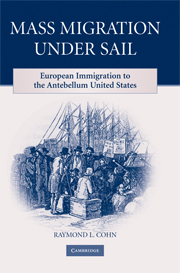Book contents
- Frontmatter
- Contents
- List of Tables and Figures
- Preface
- 1 A Unique Period for Immigration
- 2 The Onset and European Origins of Mass Immigration
- 3 The Jump in Immigrant Volume Around 1830
- 4 Push, Pull, and Other Factors in Antebellum Immigration
- 5 Who Were the Immigrants?
- 6 The Trip from Europe to the United States
- 7 The Immigrants in the United States
- 8 The Effects of Immigration on the United States
- 9 The End of Mass Migration Under Sail
- References
- Index
9 - The End of Mass Migration Under Sail
Published online by Cambridge University Press: 30 June 2009
- Frontmatter
- Contents
- List of Tables and Figures
- Preface
- 1 A Unique Period for Immigration
- 2 The Onset and European Origins of Mass Immigration
- 3 The Jump in Immigrant Volume Around 1830
- 4 Push, Pull, and Other Factors in Antebellum Immigration
- 5 Who Were the Immigrants?
- 6 The Trip from Europe to the United States
- 7 The Immigrants in the United States
- 8 The Effects of Immigration on the United States
- 9 The End of Mass Migration Under Sail
- References
- Index
Summary
The Steamship and Its Effects
The factor that led to the end of mass migration under sail was, of course, the development of the transatlantic steamship. Once Fulton demonstrated the feasibility of the steamship on the Hudson River in 1807, technological improvements were continual. Although many observers believed that a steamship would never cross the Atlantic Ocean, the first two – the Great Western and the Sirius – did so in a famous race in 1838. In 1839, the first important steamship company, the well-known Cunard Line, was founded. The British government subsidized the line to carry the mail, although Cunard's steamships also carried cabin passengers. Other steamship companies arose during the 1840s and early 1850s, almost all subsidized by some government to carry the mail. Throughout this period, the steamships mainly carried merchants and tourists and thus were not important in the immigrant trade. The situation began to change in the 1850s. Between 1852 and 1857, the Inman Line carried some steerage passengers from Liverpool to Philadelphia. Inman changed his U.S. terminus to New York City in 1857 and increased the steerage capacities of his company's ships. A number of other steamship companies, including those operating out of Germany, rapidly followed Inman's example. Thus, it was only at the end of the 1850s that steerage passage on steamships became common.
When the antebellum volume of European immigration to the United States peaked in 1854 at more than 406,000, virtually all of the passengers arrived on a sailing ship.
- Type
- Chapter
- Information
- Mass Migration under SailEuropean Immigration to the Antebellum United States, pp. 223 - 232Publisher: Cambridge University PressPrint publication year: 2008



